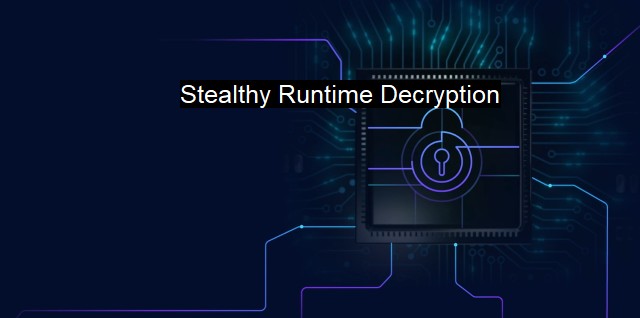What is Stealthy Runtime Decryption?
Deception in the Layers: Malicious Actors' Stealthy Technique of Runtime Decryption and its Challenge to Cybersecurity.
Stealthy Runtime Decryption (SRD) forms a key area of focus in cybersecurity and antivirus solutions. In the computer world populated with myriad types and volumes of data, SRD plays a significant role in equipping data systems with resiliency against cyber threats. Owing to its potent characteristics, anti-virus software developers employ SRD to shield high-valued digital assets from attackers' gaze.Stealthy Runtime Decryption (SRD) is a process that involves obscured translation of encrypted code into a state that can be executed by a computer system. What sets SRD apart is the subtlety of action, constructing an ideal environment for anti-virus applications to thrive. Thanks to SRD, pivotal modules of complex software can stay veiled, keeping threat actors at bay.
Encrypted code is created to protect data and maintain its confidentiality. for effective function, this code needs to be decrypted at run-time. This decryption happens in memory only when the code is executed, creating a challenge that threat actors keenly eye to exploit. After all, decrypted code remains susceptible to potential breaches and alterations. This is where SRD factors in — providing decryption of the code with the utmost stealth. This veil ensures that threat actors remain unaware of when and where operations take place, making manipulation practically impossible.
To comprehend the importance of SRD, one needs to engage the broader perspective of cybersecurity. In an era where cyber threats are evolving swiftly, multi-layered defenses are integral to outpace attacks. SRD is one fundamental layer in this defense plan, guaranteeing concealed decryption and thereby taking data security to a whole new level. SRD adheres to this multi-step defense methodology by mitigating risks of attacks surfacing from various vectors and focuses on securing runtime environments— promoting security by obscurity.
No strategy can stay effective forever; such is true in the case of SRD, too, owing to the constant push-and-pull between attackers and defenders in cybersecurity. Attacking techniques have adapted to these presented challenges, and malware capable of achieving SRD has emerged, posing severe threats to both individuals and organizations. Malware that utilizes SRD techniques raises the bar for threat sophistication, as they cloak themselves within encrypted code, unbeknownst to conventional antivirus solutions, and unveil only during runtime. Cybersecurity experts are devoted to combating this situation by developing avant-garde detection techniques capable of spotting such stealthy elements and instituting stronger security mechanisms.
Ironically, SRD symbolized the paradox of the cyber landscape. especially antivirus solutions, SRD acts as a vital instrument, teaching systems to translate in silence. On the avenue of cyberattacks, SRD manifest as sophisticated malware, endangering system integrity stealthily. Hence, the emerging scenario demands an evolved approach, which implies the development of future-proof antivirus solutions that can act upon SRD, turning attackers' weapon against them.
Stealthy Runtime Decryption serves dual roles whereby it plays defender, by working behind the scenes to secure runtime and preserve data confidentiality, and attacker, whereby it is employed by advanced malware to sneak into systems caught off guard. The balancing act of implementing SRD for cybersecurity defense and understanding its use in emergent sophisticated malware remains a significant challenge for the field. The interplay between defenders and attackers, the determination between decrypting privately and encrypting conspicuously, the balancing between safeguarding systems and breaching secured territories - all these traverse the complexity that SRD adds to the landscape of cybersecurity and antivirus. These evolving dynamics call for vigilance and innovation in the field, pointing to exciting times and challenges ahead for cybersecurity and antivirus stalwarts.

Stealthy Runtime Decryption FAQs
What is stealthy runtime decryption?
Stealthy runtime decryption is an advanced technique often used by cybercriminals to hide malicious code within a legitimate application. It involves decrypting the malicious code at runtime to avoid detection by antivirus software.How does stealthy runtime decryption work and why is it so effective?
Stealthy runtime decryption involves encrypting the malicious code within an application using sophisticated encryption techniques. The malware is only decrypted and executed at runtime, making it extremely difficult for antivirus software to detect. This technique is effective because it allows cybercriminals to bypass traditional antivirus software that relies on static analysis and signature-based detection.What are the risks associated with stealthy runtime decryption?
Stealthy runtime decryption poses a significant risk to organizations and individuals as it can allow cybercriminals to evade detection and execute malicious code on a victim's device. This can result in data theft, identity theft, financial fraud, and other serious cybersecurity threats.How can organizations protect themselves against stealthy runtime decryption attacks?
Organizations can protect themselves against stealthy runtime decryption by implementing advanced antivirus solutions that use dynamic analysis, behavioral analysis, and machine learning algorithms to detect and block malicious code at runtime. Additionally, they should ensure that all applications are up-to-date and have the latest security patches. Educating employees about safe browsing habits and avoiding suspicious downloads and attachments can also help prevent stealthy runtime decryption attacks.| | A | | | B | | | C | | | D | | | E | | | F | | | G | | | H | | | I | | | J | | | K | | | L | | | M | |
| | N | | | O | | | P | | | Q | | | R | | | S | | | T | | | U | | | V | | | W | | | X | | | Y | | | Z | |
| | 1 | | | 2 | | | 3 | | | 4 | | | 7 | | | 8 | | |||||||